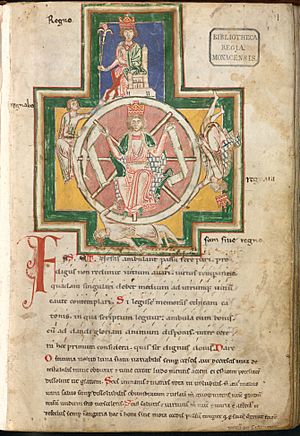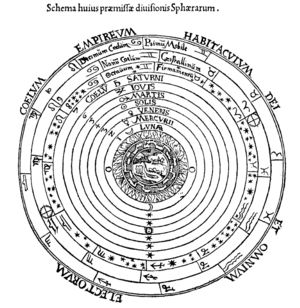Laberinto de Fortuna facts for kids
Laberinto de Fortuna (which means Labyrinth of Fortune) is a very important poem by Juan de Mena. He was a famous Spanish writer who lived from 1411 to 1456. He finished this long poem in 1444. It's an epic poem, meaning it tells a big story, and it uses a special kind of verse called "arte mayor" (which means each line has 12 syllables).
Even though the title talks about "Fortune," the poem was actually written to support a political idea. It wanted to unite the kingdom of Castile under a powerful leader named Álvaro de Luna. He was a close friend and advisor to King Juan II of Castilla. The poem also criticizes nobles who were corrupt and tells the king to take action against them. The Labyrinth was very popular in the 1400s and 1500s. Because it was a bit hard to understand, a special version with explanations for each stanza was published in 1499. The poem is also known as Las treszientas (The Three-hundred) because it has 300 stanzas, though some copies have 297.
Contents
Exploring Fortune's World: A Summary
The poem's story is like a "vision poem," which was a common type of story in the Middle Ages. You might find it similar to Dante's Inferno, which is also a vision poem. Juan de Mena himself is the person telling the story.
He starts the poem by complaining about the "unfortunate things" that happen because of Fortune. He asks to see Fortune's home to understand how she works. A chariot pulled by a dragon then takes him away!
He is guided through Fortune's home by a character called Divine Providence (who represents God's plan). There, he sees not just one Wheel of Fortune, but three! These wheels represent the past, present, and future. Each wheel has different sections, like circles, that are ruled by different planets. These circles show examples of people from history who were either good or bad.
In one special section, the seventh circle, he only sees one person: Álvaro de Luna. Luna is shown as a horseman who is controlling Fortune, like she's a wild horse.
After his tour, the narrator asks Providence for a prediction about King Juan II. Providence promises great glory for the king. But before she can give more details, the vision ends. The narrator finishes the poem by telling the king to make Providence's prediction come true. He also wonders if the whole experience was just a dream.
The Language of the Poem
The poem is written in "castellano" or Castilian, which is an old form of Spanish. It's the language that eventually became the Spanish spoken around the world today. The Spanish from Mena's time can usually be understood by Spanish speakers now.
However, Mena's language is much harder to understand. He used many old words that were not common even in his own time. He also used many words from Latin. Some of these Latin words later became part of Spanish, but most did not. This way of experimenting with language makes the poem very difficult to read. Even people living when Mena wrote it probably found it hard. A scholar named Alan Deyermond said that "the exact meaning of some lines has puzzled editors" for centuries.
How the Poem is Built: Its Structure
The poem's structure mixes two popular ideas from the Middle Ages: the Wheel of Fortune and the Ptolemaic universe. As mentioned, the poem is built around three Wheels of Fortune: past, present, and future.
The narrator can see the first two wheels, but Providence keeps the third one (the future) hidden. Providence explains that the past and future wheels don't spin. But the wheel for the present is still moving, meaning its outcome is not yet decided.
On each wheel, the narrator sees people from ancient history or Castilian history. They are shown at different levels of fortune. These different levels are shown using the Ptolemaic structure. Each wheel is like a small version of the Ptolemaic universe. This universe had seven known planets, and each planet had its own special meaning. The Ptolemaic idea is very important to how the story moves forward. The narrator travels through the rings of the different planets.
To sum it up: There are three Wheels of Fortune. Each Wheel has seven rings, and each ring represents a planet and its good qualities. But only two of the Wheels can be seen by the narrator. On each ring, there are historical people who either show or lack the good quality of that planet.
Challenges in the Poem's Structure
Mena's structure for the poem is complex. It might not make complete sense to readers today. When we look closely, we see that he doesn't always follow the plan of wheels and circles he set out at the beginning. This is because his main goal wasn't just to talk about Fortune. He wanted to share a political message. Because of this, he left some structural problems in the poem.
First, his idea of three wheels (past, present, and future) doesn't quite fit the usual idea of the Wheel of Fortune. The Wheel of Fortune usually shows past, present, and future all at different points as it spins.
Providence says the narrator will see the present wheel moving. This is supposed to show that present lives are still changing. But the wheel is actually shown as standing still. A second problem is that the "present" wheel doesn't have people from the actual present. It has people from the recent past. Only the narrator, King Juan II, and Álvaro de Luna were alive when the poem was written. Mena likely did this to avoid upsetting powerful people at the time.
Perhaps the biggest problem is that the Wheels don't really show how unpredictable Fortune is. Instead, they show that good actions are rewarded and bad actions are punished. They show a clear and lasting moral system, not a changing one. So, the poem, which seemed to be about Fortune, actually avoids that topic.
Finally, the Ptolemaic rings and the Wheels of Fortune don't really fit together in a way that makes visual sense. By the end of the poem, Mena ignores his own structure. He replaces it with praise for Álvaro de Luna.
It's also interesting that the Laberinto (Labyrinth) actually doesn't have a labyrinth in it! Fortune's home is described as a house, with three wheels and their rings, not a maze. Scholars generally think the "labyrinth" in the title refers to the confusing political situation in Castile at the time.
Why the Poem Was Important: Its Political Message
Given the poem's difficult language and structural issues, you might wonder why it was so respected. Part of the answer is its purpose. The main goal of the poem was to be political propaganda. Because of this, its weaknesses in structure didn't seem as important. If readers understood the political message, Mena had succeeded.
Scholars believe Mena gave the poem to King Juan II in person in 1444. The poem aimed to be a great Spanish epic. It wanted to inspire a sense of nationhood for Castile. It showed Castile's future (unity and the Reconquista, which was the Christian reconquest of Spain) in an epic way. It also made it clear that Luna was the hero who should lead this task.
The poem's complex structure and vocabulary were meant to impress King Juan II. The king himself wrote poetry and supported many poets. Mena's difficult poem was designed to flatter the king. It aimed to convince him to keep supporting Álvaro de Luna. In one of the most famous parts of the poem, Luna "cavalga sobre la fortuna" (rides astride Fortune). Fortune is shown as a wild horse that the heroic Luna has tamed.
What Happened Next: Historical Impact
Mena's poem might have achieved its political goals for a short time. Mena gave the poem to the king in 1444 during a difficult period. King Juan II was being held by his rival cousins from Aragón and Navarra. Perhaps partly inspired by the poem, the king supported Luna again. Luna reached his highest power after the First Battle of Olmedo in 1445.
However, in 1453, Luna was beheaded on the king's orders. King Juan II himself died not long after. Mena spent his final years knowing that his political goals had not been fully achieved.
Even so, the poem itself survived and became very popular. This was partly because of the political discussions that continued about Álvaro de Luna. Today, it is seen as one of the most important works from late-medieval Spain.
See also
 In Spanish: Laberinto de Fortuna para niños
In Spanish: Laberinto de Fortuna para niños



